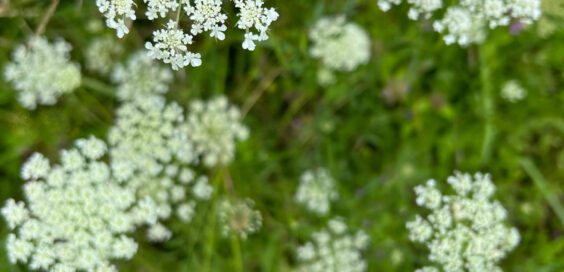
Creature Feature – Beauty Queen
Posted by Dustin Horton // August 31, 2023 // Articles, Creature Feature
Stroll along any rural road this month and you’ll likely spy Queen Anne’s Lace, a classic summer wildflower. Queen Anne’s Lace is also called Wild Carrot, Bishop’s Lace, and Bird’s Nest Flower. Its blooms are comprised of frothy clusters of tiny white flowers that curl inward after the plant goes to seed, forming a shallow cup resembling a bird’s nest.
Despite its familiarity, Queen Anne’s Lace is not native to North America but to Afghanistan and adjacent regions where it spread to parts of Europe. European settlers then brought the plant to North America for use as a medicinal herb. Historically, it’s been used in traditional Chinese medicine and by different Native American tribes, and was also used to treat wounded soldiers during the Civil War. Today, herbalists still use teas, extractions, and infusions made from various parts of the plant. However, using Queen Anne’s Lace without proper knowledge can be dangerous. Allergic reactions like blisters and dermatitis have been reported. Also, the plant looks similar to other members of the carrot family that are highly toxic, including Poison Hemlock and Water Hemlock, which can cause paralysis and death.
Legends differ as to how this wildflower got its regal name. One traces the moniker back to Saint Anne, the maternal grandmother of Jesus and the patron saint of lace-makers. Another points to Britain’s Queen Anne [1574 – 1619] who often wore lacy medallion patterns reminiscent of its showy blooms. Supposedly, during the 18th century, Queen Anne II challenged her ladies-in-waiting to tat pieces of lace more exquisite than the flower – but none could match the Beauty of Mother Nature’s original.
Article & photo Margie Manthey













